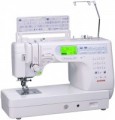Number of stitches
The number of stitches that a sewing machine can sew. The larger this number, the more extensive the capabilities of this model, the wider the choice the user has; however, it wouldn’t hurt to clarify the specific range of supported stitches separately.
The fewest options - mostly up to 25 - are provided in electromechanical machines, as well as specialized devices such as overlockers and carpet lockers (see “Type”). In computer-controlled devices, the number of lines can be in the dozens, and some also allow you to download additional options from the computer.
Number of loops
The number of welt stitches that a sewing machine can make. Different types of loops are used for different types of fabrics and clothing. The larger this number, the wider the choice the user has and the less likely it is that the machine’s arsenal will not have the required type of loop.
Presser foots
Виды лапок, поставляемых в комплекте со швейной машинкой.
— Универсальная. Лапка, используемая для стандартных швейных операций — преимущественно прямых строчек и зигзагов.
—
Лапка оверлочная. Лапка, предназначенная для выполнения оверлочной обработки. По определению встречается в устройствах с функцией оверлока (см. «Тип»), однако может предусматриваться и в традиционных швейных машинках. В последнем случае такая лапка, разумеется, не заменит полноценного оверлока, однако в некоторых ситуациях она позволяет обойтись без него.
—
Верхний транспортер ткани. Дополнительный транспортер для ткани, устанавливаемый сверху, вместо штатной лапки в дополнение к стандартному нижнему транспортеру. Такое приспособление облегчает работу с тонкими, деликатными и скользящими тканями, а также сшивание вместе нескольких слоев ткани: материал сдвигается максимально равномерно, без перекосов и смещений.
—
Лапка для вшивания молнии. Лапки для вшивания молнии могут иметь разный размер и конструкцию — в частности, существуют специальные приспособления для вшивания потайной молнии. Конкретные особенности данного приспособления стоит уточнять отдельно.
—
Лапка для декоративной строчки. Лапки, предназначенные для различных разновидностей декоративной строчки. Такая строчка может и не иметь функциональной
...роли, ее основная задача — подчеркнуть определенный элемент одежды (края, карманы, отдельные швы и т. п.). В любом случае линия стежков обычно должна строго следовать контуру, вдоль которого она наносится — а этот контур может состоять как из прямых, так и из кривых линий. Специальные лапки для декоративной строчки упрощают задачу: они оснащаются линейками или другими приспособлениями, позволяющими контролировать параллельность стежков.
— Лапка для атласной строчки. Данная лапка будет пригодна для аппликаций и другой работы, где часто используется зигзагоподобные стежки.
— Лапка для потайной строчки. Лапка, предназначенная для потайных швов, применяемых при подгибании края ткани. Оснащается приспособлением, которое обеспечивает подгиб ткани и в таком положении подает ее под иглу.
— Лапка для квилтинга. Специальные лапки для выполнения квилтинга — лоскутного шитья. При таких работах приходится сшивать ткань в несколько слоев, а также выполнять фигурные швы. В крайнем случае для квилтинга можно применять и обычную универсальную лапку, но пользоваться специальным приспособлением все же значительно удобнее.
— Лапка для вышивания монограмм. Лапка для вышивания монограмм позволит сделать вышивку на любом объекте, тем самым «украсив» его своей подписью или же эмблемой какого-либо учреждения, фирмы, спортивного клуба.
— Лапка для выметывания петли. Лапка, предназначенная для образования петель. С ее помощью отпадает надобность в ручной работе. Все за вас сделает швейная машинка, что и время сократит, и качеством порадует.
— Лапка для пришивания пуговиц. Лапка, предназначенная для фиксации пуговицы на ткани во время пришивания. Имеет специальный выступ, направленный вниз: когда основная часть лапки прижимается к пуговице, этот выступ прижимает ткань и предотвращает ее скольжение.
Кроме вышеназванных, в комплект поставки могут включаться и другие виды лапок — например, для атласной строчки, для обработки срезов и т.п.Sewing advisor
Built-in help system that displays various tips on the display. Some sewing advisers are capable of providing very detailed information, step-by-step instructions with pictures and control of settings (if the settings are incorrectly set, the device issues a warning). This feature is especially useful when learning to sew for the first time, but it can also be useful for an experienced sewer who is faced with an unusual task.
Ruler on body
The ruler scale applied directly to the body of the sewing machine. This feature allows you to simplify and speed up some measurements in the process of work: attaching the measured segment to the body of the machine is often more convenient than looking for a ruler or centimetre tape.
Cover
The type of cover supplied with the sewing machine.
-
Soft. A soft fabric cover protects the machine mainly from dust and dirt and provides almost no protection from bumps and collisions. At the same time, having removed such a cover for the duration of work, it can be folded compactly.
-
Hard. A cover in the form of a hard cover put on from above or a case in which the machine fits. Such a cover is rather bulky, it cannot be folded like a soft one; on the other hand, it protects the machine well both from dirt and from collisions and contact with solid objects.

